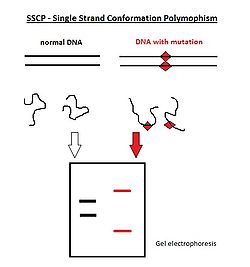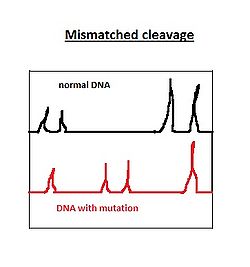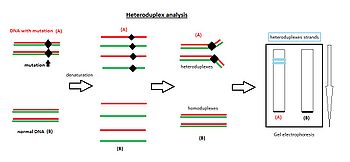DNA Diagnostic Direct Methods
DNA direct methods are still pretty new and are only recently becoming more popular. Just a few years ago it was sci-fi to use them. In order to use it, it is necessary to know the exact sequence of DNA segment that you are looking for. Compared to the indirect methods, they use different probes - oligonucleotide probes. We can get them by the process of sequencing.
There is one big advantage of direct methods. You can also find affected people without positive family history. We can identify the only one carrier in the family. The disadvantage is the very high costs associated with this examination.
The direct methods do not look for genes connected with some disease. They search specific nucleotide sequence of DNA, which leads to disease. So it is necessary to know how it looks like.
We recognize a few types of DNA direct diagnostics:
SSCP - Single Strand Conformation Polymorphism[edit | edit source]
- a single strand of DNA is able to create some secondary structure according to a temperature and other surrounding conditions
- structure determines how fast the DNA passes through electrophoresis gel
- highly sensitive method - just one nucleotide change leads to different speed of passage
- we compare normal DNA with the affected one
DGGE - Denaturing Gradient Gel Electrophoresis[edit | edit source]
- the structure of DNA determines a melting point
- mutation leads to change in electrophoresis
Heteroduplex analysis[edit | edit source]
- depends on a complementarity of DNA strands
Mismatched cleavage[edit | edit source]
- DNA strand is divided in a place where the double stranded structure is not complete - in the place of mutation
Links[edit | edit source]
Related articles[edit | edit source]
Bibliography[edit | edit source]
- SOUKUPOVÁ, SOUKUP,. Kapitoly z lékařské biologie a genetiky II. 2. edition. 2005. ISBN 80-7184-581-7.
| This article is a stub. You can join the authors and edit it. You can discuss the changes at discussion. |




